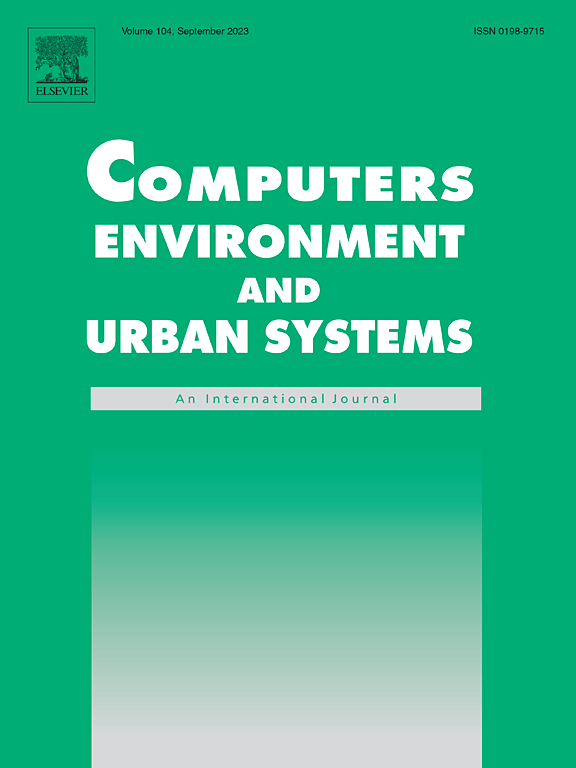Analyzing public response to wildfires: A socio-spatial study using SIR models and NLP techniques
IF 8.3
1区 地球科学
Q1 ENVIRONMENTAL STUDIES
Computers Environment and Urban Systems
Pub Date : 2025-08-01
DOI:10.1016/j.compenvurbsys.2025.102333
引用次数: 0
Abstract
The increasing frequency and severity of wildfires pose significant risks to communities, infrastructure, and the environment, especially in Wildland-Urban Interface (WUI) areas. Effective disaster management requires understanding how the public perceives and responds to wildfire threats in near-real-time. This study uses social media data to assess public responses (including collective perceptions/reactions) and explores how these responses are linked to city-level community characteristics. Specifically, we leveraged a transformer-based topic modeling technique called BERTopic to identify wildfire response-related topics and then utilized the Susceptible-Infectious-Recovered (SIR) model to compute two key metrics — public response awareness and resilience indicators. Additionally, we used GIS-based spatial analysis to map wildfire responses and the relationships with four groups of city-level factors (racial/ethnic, socioeconomic, demographic, and wildfire-specific). Our findings reveal significant geographic and socio-spatial differences in public responses. Southern California cities with larger Hispanic populations demonstrate higher wildfire awareness and resilience. In contrast, urbanized regions in Central and Northern California exhibit lower awareness levels. Furthermore, resilience is negatively correlated with unemployment rates, particularly in southern regions where higher unemployment aligns with reduced resilience. These findings highlight the need for targeted and equitable wildfire management strategies to improve the adaptive capacity of WUI communities.
分析公众对野火的反应:使用SIR模型和NLP技术的社会空间研究
野火发生的频率和严重程度日益增加,对社区、基础设施和环境构成了重大风险,特别是在荒地-城市交界地区。有效的灾害管理需要了解公众如何近乎实时地感知和应对野火威胁。本研究使用社交媒体数据来评估公众的反应(包括集体的看法/反应),并探讨这些反应如何与城市层面的社区特征联系起来。具体来说,我们利用一种名为BERTopic的基于变压器的主题建模技术来识别与野火响应相关的主题,然后利用易感-感染-恢复(SIR)模型来计算两个关键指标——公众响应意识和恢复指标。此外,我们使用基于gis的空间分析来绘制野火响应及其与四组城市层面因素(种族/民族、社会经济、人口统计学和野火特异性)的关系。我们的研究结果揭示了公众反应的显著地理和社会空间差异。西班牙裔人口较多的南加州城市表现出更高的野火意识和恢复能力。相比之下,加州中部和北部的城市化地区表现出较低的意识水平。此外,弹性与失业率呈负相关,特别是在南部地区,高失业率与弹性降低相一致。这些发现强调需要有针对性和公平的野火管理战略,以提高WUI社区的适应能力。
本文章由计算机程序翻译,如有差异,请以英文原文为准。
求助全文
约1分钟内获得全文
求助全文
来源期刊

Computers Environment and Urban Systems
Multiple-
CiteScore
13.30
自引率
7.40%
发文量
111
审稿时长
32 days
期刊介绍:
Computers, Environment and Urban Systemsis an interdisciplinary journal publishing cutting-edge and innovative computer-based research on environmental and urban systems, that privileges the geospatial perspective. The journal welcomes original high quality scholarship of a theoretical, applied or technological nature, and provides a stimulating presentation of perspectives, research developments, overviews of important new technologies and uses of major computational, information-based, and visualization innovations. Applied and theoretical contributions demonstrate the scope of computer-based analysis fostering a better understanding of environmental and urban systems, their spatial scope and their dynamics.
 求助内容:
求助内容: 应助结果提醒方式:
应助结果提醒方式:


